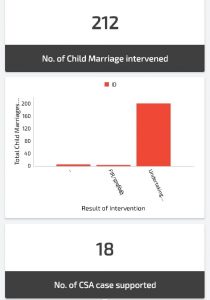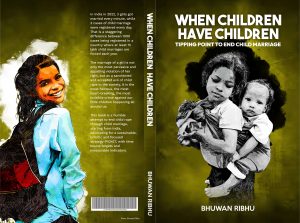
About our organization
Banwasi Vikas Ashram (BVA) is dedicated to the development of the deprived people (backward and poor rural women, people with disabilities, child labour, victims of trafficking and violence) in Giridih district of Jharkhand state. The organization is working on the following issues of Child Marriage, Child Trafficking, Child Labour and Child Sexual Abuse. The organization participated and organized Child Marriage Free India Campaigns in Giridih districts of Jharkhand state covering over 150 villages under the project.
The Campaign Activities included:
1. Akshaya Tritiya Campaign – Akshaya Tritiya campaign was organized during 22 Apr, 2023 and conducted events in Harihar Dham Temple in Bagodar block. The campaign reached out to 5 religious leaders to pledge to prevent and end child marriage in their villages, districts.
2. June Action Month – Banwasi Vikas Ashram conducted the action month with the objective of Child Marriage Free India and prevented 9 child marriages through undertakings, and 4 FIRs got registered. The campaign was conducted in collaboration with Kailash Satyarthi Children Foundation-US and Government departments and covered by Print and Digital media with an outreach of directly and through online.
3. 16 October 2023 – Child Marriage Free India Campaign Event – The campaign event was conducted in Schools, Panchayat Offices, Anganwadis, Communities, Temples, Mosque and Government Offices covering 150 villages in collaboration with Kailash Satyarthi Children Foundation-US and Government departments with notifications issued by the District Collector, District Social Welfare officer, District Child Protection Unit, Education departments. The campaign was organized in Giridih districts, and 2771 villages of 13 Blocks with an outreach of Child Marriage Free India. On this day 210,000 people took pledge against Child Marriage.
Child Marriage Free India (CMFI) is a nation wide campaign lead by women leaders. Banwasi Vikas Ashram is working tirelessly to eradicate child marriage in the Giridih district of Jharkhand state.
According to NHFS-5 (2019-21), Giridih district is at 4th position in terms of child marriage in Jharkhand state. Women age 20-24 years married before age 18 years is 45.6%.



Overall, the campaign likely had a positive impact on reducing the prevalence of child marriage in Giridih district and promoting the well-being and rights of children. Ongoing monitoring and evaluation efforts will be important to assess the long-term effectiveness of the campaign and identify areas for further improvement.
Background
Child marriage is not just an age-old social evil, but also a heinous crime that robs children of their childhood. Child marriage is a “crime against children” that violates basic human rights, minor girls are forced to marry and live a life of mental trauma, physical and biological stress, domestic violence including limited access to education and increased vulnerability to domestic violence. The consequences of child marriage are severe and extensive. Some of the specific consequences include: early pregnancies leading to complications and higher rate of maternal mortality and death of infants, malnutrition among both the infant and the mother, increased vulnerability to reproductive health, disruption in girl’s education and thereby reduction in opportunities of her personal and professional development, domestic violence and abuse, limited decision making powers in the household, and mental health issues.
India’s Census 2011 revealed 12 million children were married before attaining the legal age, of which 5.2 million were girls. Globally, child marriage is identified as a crime and a menace that needs to be eliminated. It finds space in the UN Sustainable Development Goals, under target 5.3 of Goal 5 that states elimination of all harmful practices, such as child, early and forced marriage and female genital mutilation by 2025.
The latest National Family Health Survey (2019-21) shows that although there is a drop in the overall rate of child marriages, from 26.8% in the National Family Health Survey (NFHS 4) to 23.3% in NFHS-5, it is still high despite laws, programmes and schemes in place to address the issue.
Child Marriage Free India Campaign
Understanding the seriousness of the issue, the Hon’ble Supreme Court of India in W.P. Civil 382 of 2013 pronounced that the sexual intercourse committed by the husband upon his wife being under the age of 18 years with or without her consent can be constituted as rape. To address this, the most definitive and audacious commitment to end child marriage was made with the launch of Child Marriage Free India campaign.
Child Marriage Free India (CMFI) is a nationwide campaign led by women leaders and a coalition of more than 160 NGOs spanning more than 300 districts working to eliminate child marriage in India. CMFI is working to attain the tipping point of child marriage, after which the society does not accept this evil practice and that will happen when the prevalence of child marriage is brought down to 5.5% by 2030, from the current national prevalence rate of 23.3%. This is being done by initially targeting 257 high-prevalence districts and gradually focusing on all the districts of the country.
Child marriage results in child rape, resulting in child pregnancy, and in a large number of cases, may lead to child deaths. For decades, we have been losing generations of our children to child marriage. The Child Marriage Free India campaign has received extended support from various Departments and Institutions of over 28 States. So far, across India more than 5 crore people have taken the pledge to end child marriage over the last one year through the efforts of the Child Marriage Free India Campaign.
Know more about the Child Marriage Free India (CMFI) Campaign: https://www.childmarriagefreeindia.org/

Tipping Point to end child marriage
Noted child rights activist, author, Supreme Court lawyer and founder of CMFI campaign, Bhuwan Ribhu has authored a book – ‘When Children Have Children: Tipping Point to End Child Marriage’ and put forth a framework advocating a sustainable, holistic and focused strategy with time-bound targets and measurable indicators to make India child marriage free by 2030. This book shows the path to eliminating child marriage in India within the next decade. As suggested by the author in the book, by adopting a systematic, highly focused, and intensive intervention model, over a phased timeline it is possible to reduce the national child marriage prevalence levels to 5.5% —the threshold, the tipping point, beyond which the prevalence is anticipated to diminish organically with reduced reliance on targeted interventions.
Tipping Point Methodology
The aim of reduction of 60% of child marriage (in each of the phases) is assumed to bring down the incidence of child marriage to 5.5% in the next 9 nine years from 2021, from the last available estimates i.e., NFHS-5, till 2030. An additional assumption is that such a focused and elaborate intervention against child marriage would have a ripple effect. The tipping point analysis has been divided into two phases. The first phase will extend over a period of six years, starting in 2021. Subsequently, the second phase will span over a three-year period. It is expected that the national average for child marriage prevalence (percentage women aged 20-24 who were married before 18 years) would decline from 23.3% to 13.7% if the prevalence of child marriage is reduced by 60% in the 257 high-prevalence districts in the first phase followed by a further reduction of 60% in all districts across the country.
In order to reach the Tipping Point, the author has proposed a strategy at national and district level.
- National Level strategy where Governments, Institutions, statutory bodies, etc. work towards prevention, protection, increased investment, improved prosecution, convergence and use of technology for monitoring
- District Level strategy is similar to national level strategy but includes district administration, Panchayats, civil society, NGOs, other functionaries, parents and children who work collectively to prevent, report, and take action against child marriage.

PICKET Strategy to End Child Marriage
Addressing the issue of child marriage, requires a comprehensive and coordinated approach of different government departments, institutions, statutory bodies, and civil society organisations.

Case Study – Preventing Child Marriage
Rescuing Parvatiya: A Case Study of Child Marriage in Tribal Village of Giridih, Jharkhand.
Background:
- Parvatiya, 16 years-old girl, belonged to a tribal family in a remote tribal dominated area in the Pirtand block of Giridih. Due to their financial struggles, Parvatiya’s parents were ready to arrange her marriage.
Rescue operation:
- In early 2023, Banawasi Vikas Ashram NGO, known for its dedication towards eradicating child marriage. The Community Social Worker got to know about the Parvatiya during an awareness program in Parvatiya’s community. The CSW immediately verified the age of Parvatiya from her school where Parvatiya is studying in class 8. After the age verification CSW went to Parvatiya’s home and met her family. CSW warned their parents about the Child Marriage Act-2006 and effect of child marriage. After the discussion, Parvatiya’s parents were ready to sign the undertaking form and promised to CSW that before 18 years of age they will not marry her daughter.
- In the presence of Panchayat Secretary, they signed the undertaking form.
Rehabilitation and Support:
- Banawasi Vikas Ashram NGO, is recognized for its comprehensive rehabilitation programmes. BVA assisted Parvatiya in filling out the sponsorship scheme form and applying. BVA assisted Parvatiya in attending school, where she continued her further education.
Future prospects:
- Parvatiya’s educational journey began under the guidance of the NGO. Now she attend the classes regularly. The organization ensured that she will receive proper schooling and opened doors to a brighter future.
Conclusion:
- Parvatiya’s case serves as a poignant example of the prevalence of child marriage in rural areas. The intervention by the Banwasi Vikas Ashram NGO brought an end to her circumstances and provided her with hope for a better life. This case study highlights the crucial role NGOs play in rescuing and rehabilitating child marriage victims, ultimately helping them reclaim their childhood and secure a dignified future.
